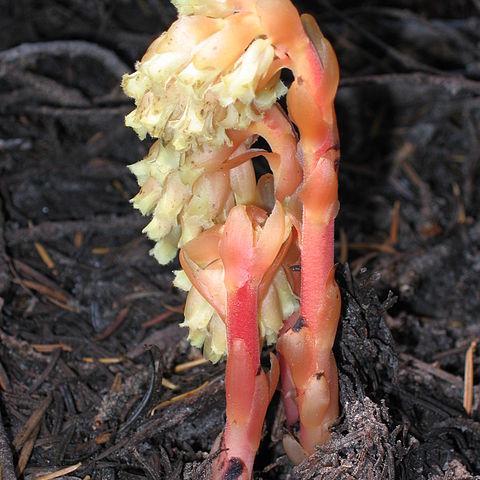Fleshy herbs lacking chlorophyll, blackening in drying; tawny, reddish or orangey to translucently white; mycorrhizal root parasites (often considered saprophytic); flowering stems nodding at tip but erect in fruit, 1-15 flowers each borne in the axil of an upper more or less appressed, erose-margined bract, the pedicels recurved, ebracteolate. Flowters (3-)4-5(-6)-parted; calyx of 1-5, lanceolate, deciduous, bractlike scales; corolla campanulate, (3-5)6-parted, the petals erect, imbricate, scalelike, distinct, basally saccate and tardily deciduous; stamens 8-10(-12), the filaments distinct, terete, subulate, pubescent, the outer whorl (opposite the petals) shorter than the inner, the anthers short, kidney-shaped, 1-locular at anthesis, opening by a single terminal slit or by ends of a slit which may later open along its entire length; pollen grains single; nectaries of 8-10 paired lobes between the filament bases; stigma funnel-shaped to discoid, obscurely 4-6-lobed, the style columnar, thick, fleshy, the ovary superior, (8) 10-lobed, (4-)5(-6) loculate basally with axile placentation, I-locular above with 4-5, bibbed parietal placentas. Capsule globose to ovoid, 8-10-grooved, erect, loculicidally 4-6-valved; seeds numerous, minute, tailed.
Herbs perennial, mycoparasitic, lacking chlorophyll. Axis nodding, white to reddish. Leaves absent or reduced to laminar structures. Inflorescence scapose or racemose arising from persistent root system. Flowers solitary or in several-flowered racemes, often nodding at anthesis, usually erect in fruit, bracteate. Sepals 4 or 5, usually appressed to petals. Petals 3–6, oblong, often saccate at base, apex dilated. Stamens 8–12 in two series of alternating unequal lengths; anthers horizontally reniform, with terminal slit. Disk of 8–10 distended paired lobes adnate to base of ovary. Ovary (3–)5(or 6)-loculed, with axile placentation; style base sharply differentiated from ovary. Capsules globose to narrowly ovoid, loculicidally dehiscent, valves with marginal fibers; perianth segments early deciduous at fruiting. Seeds many, fusiform, minute; testa thin, prolonged at both ends, minutely reticulate. n = 16, 24.
Pet 4–6(–8), distinct, all or some saccate at base, the cor urceolate or broadly tubular; sep 0–5; stamens 8 or 10 (–14), on slender, hairy filaments, alternately longer and shorter; anthers transverse, opening by 1 or 2 clefts across the top; ovary 4–5(6)-locular; style short, thick; stigma broad, peltate, umbilicate; capsule ovoid to subglobose, loculicidal, opening from the top downward; white, yellow, pink or red plants, turning black in drying, with erect stems beset with small scale-lvs, nodding fls the same color as the stem, and erect frs. 2, N. Hemisphere.

